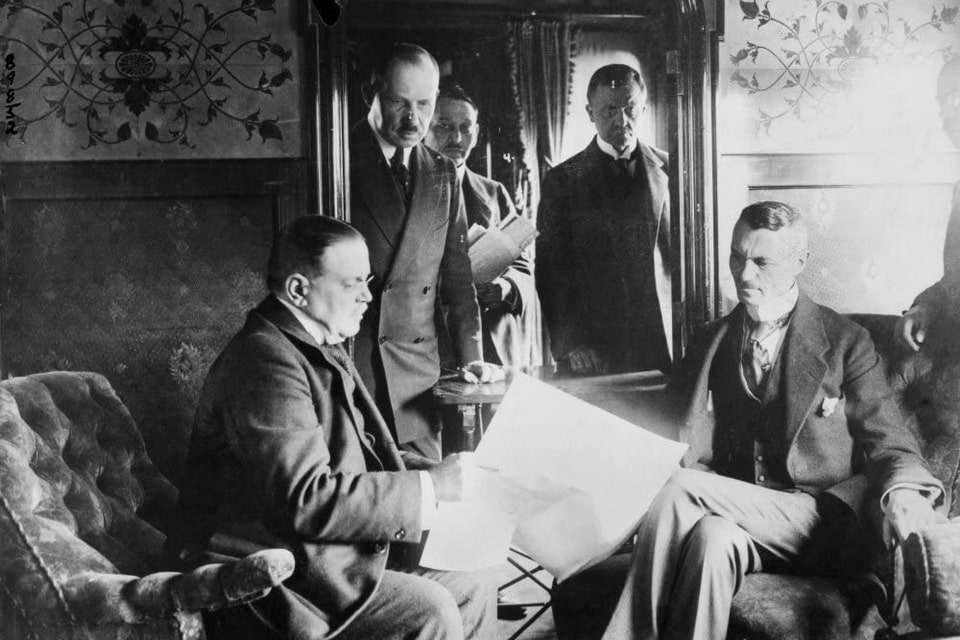
Model of the Month: Historical significance of the Compiegne wagon
Welcome to this week's blog.
Before I launch into the Model of the Month feature, I wanted to let you know that the first delivery of the Executive Edition Lancasters arrived today - woohoo! All I can say is wow - you are in for a treat. By the Royal Mail cut off time today, we were part way through fulfilling a huge number of pre-orders so please bear with us and we hope to get the rest out to you by the end of Monday. To add to it, Royal Mail wouldn't take all of the parcels - apparently 124 was too many! So we have booked two extra trolleys for Monday's collection. You may have received tracking number for an item which wasn't collected so please bear with us until Monday. Thank you for your understanding. I'm ready for a large glass of wine.
If you missed out on the first delivery of Lancasters which all sold out then we have more on the way as well as the Standard Edition Lancasters plus backorders which are due in stock towards the end of next week - details below.
Also, if you are interested in the Christmas themed sets COBI recently promoted on social media, please let us know ASAP. COBI told us they have had a very large pre-order from a retailer for the entire collection, so we are trying to get hold of as many as we can (if we can) for our customers who have already expressed an interest.
As always, thanks for your custom and support and please let us know any feedback either in the comments below or email: admin@bricktanks.co.uk.
Have a good weekend.
Warmest wishes,
Zoë
P.S. I've added some new figures to the upcoming 'Imperium Romanum' Collection - click the link below for more.
Before I launch into the Model of the Month feature, I wanted to let you know that the first delivery of the Executive Edition Lancasters arrived today - woohoo! All I can say is wow - you are in for a treat. By the Royal Mail cut off time today, we were part way through fulfilling a huge number of pre-orders so please bear with us and we hope to get the rest out to you by the end of Monday. To add to it, Royal Mail wouldn't take all of the parcels - apparently 124 was too many! So we have booked two extra trolleys for Monday's collection. You may have received tracking number for an item which wasn't collected so please bear with us until Monday. Thank you for your understanding. I'm ready for a large glass of wine.
If you missed out on the first delivery of Lancasters which all sold out then we have more on the way as well as the Standard Edition Lancasters plus backorders which are due in stock towards the end of next week - details below.
Also, if you are interested in the Christmas themed sets COBI recently promoted on social media, please let us know ASAP. COBI told us they have had a very large pre-order from a retailer for the entire collection, so we are trying to get hold of as many as we can (if we can) for our customers who have already expressed an interest.
As always, thanks for your custom and support and please let us know any feedback either in the comments below or email: admin@bricktanks.co.uk.
Have a good weekend.
Warmest wishes,
Zoë
P.S. I've added some new figures to the upcoming 'Imperium Romanum' Collection - click the link below for more.
New releases on the way
Due in stock 18th - 23rd September.
Backorders also on the way!
COBI Christmas Collection
Please email us at admin@bricktanks.co.uk if you are interested in any of these brick models/decorations which are due for release in October.







Model(s) of the Month for September:
Compiegne wagon brick model kits by COBI
Compiegne wagon brick model kits by COBI
To celebrate not one but two versions of the Compiegne wagon kit coming into production early November, we have taken a deep dive into the history behind this fascinating train carriage.
The Compiegne Wagon: A Symbol of Victory and Humiliation
The Compiegne Wagon, a railway carriage with a storied history, stands as one of the most poignant symbols of both triumph and defeat in European history. Its role during two significant moments of the 20th century—the end of World War I and the height of World War II. This blog delves into the rich history of this iconic railway carriage, exploring its journey from a simple transport vehicle to a potent symbol of political and military power.
The First World War and the Armistice of 1918
The story of the Compiegne Wagon begins during the First World War. Manufactured in 1914, this railway carriage, officially known as "Wagon-Lits 2419D," was initially part of a fleet used by the French army. Its most famous moment came on 11 November 1918, when it was chosen by Marshal Ferdinand Foch, the Supreme Allied Commander, as the site for the signing of the Armistice that ended World War I.
The signing took place in a secluded forest clearing near the town of Compiegne, in northern France. The choice of this location and the wagon was not random; the secluded site was selected for its quietness, away from the prying eyes of the world’s press, and the wagon provided a controlled environment for the signatories. Within the wooden walls of the wagon, representatives of the Allied powers and the German delegation signed the document that effectively brought an end to four years of devastating conflict. For the French, the wagon became a symbol of victory and national pride, a reminder of their resilience and eventual triumph over an invading force.

The Second World War: A Moment of Reversal
The Compiegne Wagon’s significance was far from over. In June 1940, during the early stages of the Second World War, the French were forced to endure a bitter and symbolic reversal of the events of 1918. Following the rapid advance of the German forces through France, the French government sought an armistice. The choice of the location and the wagon for the signing of this armistice was no accident—it was deliberately chosen by the German leadership to humiliate the French by reversing the symbolic victory of the previous war.
On 22 June 1940, in the very same clearing in Compiegne, French officials were compelled to sign the armistice in the same railway carriage where the 1918 agreement had been concluded. The victorious German forces had gone to great lengths to ensure that the symbolism of the event was not lost, even going so far as to move the original wagon back to the clearing from its display location in Paris. The act was intended to remind the French of their defeat and to draw a stark contrast between the two world conflicts.

The Wagon’s Final Journey
After the signing of the 1940 armistice, the Compiegne Wagon was taken to Berlin, where it was displayed as a trophy of victory. However, its fate took a tragic turn towards the end of the war. In 1945, as the Allied forces advanced into Germany, the carriage was moved to a location in the German countryside. In the final days of the war, it was deliberately destroyed, most likely to prevent it from becoming a symbol of Allied victory.
Despite its destruction, the legacy of the Compiegne Wagon endures. The clearing where the armistices were signed remains a site of historical significance. A replica of the original wagon (pictured below), along with a museum, now stands at the location in Compiegne, serving as a reminder of the complex and often painful history associated with it.
The story of the Compiegne Wagon is a powerful reminder of how objects can transcend their ordinary functions to become symbols of broader historical narratives. From a site of triumph in 1918 to one of humiliation in 1940, the wagon’s journey reflects the shifting tides of power and the enduring significance of memory in the landscape of European history.

 Skip to content
Skip to content


Mark C
If the Lancs are as good as the Do17 and the B-24 they’ll have been worth the wait.
I’ll let you know. :)